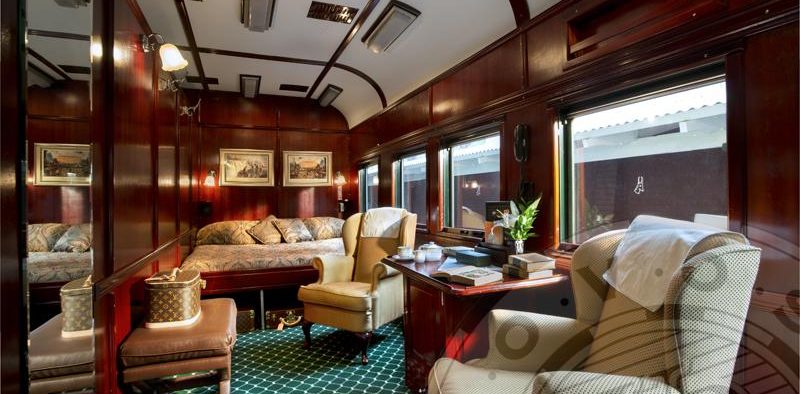Rovos: Discover a Paradise
Share


The cabin is best described as a 5-star accommodation on wheels
It was the end of Indaba 2015 in Durban, South Africa. After a three day show of the biggest travel event in Africa, it was time to travel to Pretoria, the administrative capital of the country. There was curiosity in the air concerning the mode of transportation, Rovos Rail!
After a short drive from Southern Sun Elangeni, Durban’s iconic grandeur hotel, we arrived at the train station greeted by well-dressed hostesses with glasses of champagne and orange juice. Then it was time for the red-carpet check-in to the Rovos train. Rohan Vos, the rail owner, is on board and personally read out the lengthy rules passengers must adhere to in other to enjoy the most luxurious train in the world.
In April 1989, a locomotive and seven carriages carrying on board four paying passengers, friends and press set off for the Eastern Transvaal, today’s Mpumalanga province in South Africa. That journey heralded what is now famous as the Rovos Rail, regarded as the most luxurious train in the entire world. Rohan Vos, young successful businessman, founder and owner of Rovos Rail takes the challenge of bringing and restoring pride to Africa via rail transportation.
“This train is meant for absolute relaxation,” he explained, “hence no Wi-Fi on board and the use of mobile phone is strictly prohibited in the public areas and hopefully we will get to Pretoria sometime tomorrow. As all the passengers checked-in to their various cabins, the train began its journey. A hostess is assigned to two cabins to cater for all the needs of the travelers. Just by dialling the in-cabin phone a hostess will attend to your needs.
The cabin is best described as a 5-star accommodation on wheels with a mini king-size bed and expansive duvet; a mini bar; a kit that includes body amenities and a dosage of pain relief drug in case of injuries. The well-lit cabin also has electricity power sockets, air conditioning while travellers are offered complimentary shoe shining service. Also in the cabin is a private bathroom and toilet that is fitted with a modern hand-held shower, surplus luxurious bath soaps, gels and a simple hand-pull device to heat the bathroom in the event of cold.
There are three categories of cabins; The Royal Suites, which takes up half of the carriage, are spacious and elegant measuring ±16 sq metres in size. Each has its own private lounge area and full bathroom with Victorian bath and separate shower. An epitome of luxury with handsome wood panelling and Edwardian features, the air-conditioned suites accommodate two people offering the option of side-by-side twin or spacious double beds. In the en-suite bathrooms, original fittings combine with the modern technology of hot showers, hair dryers and shaver plugs. The Deluxe suites which are ±10 sq metres/±118 sq feet accommodate two passengers in either twin or double beds and have a lounge area and en-suite bathroom with shower. The wood-panelled rebuilt sleeper coaches, remodelled and refurbished, offer every modern convenience and comfort.
The Pullman suites, ±7 sq metres/±76 sq feet are equipped with a comfortable sofa-seat during the day with a conversion to double or twin beds for the evening, and also have an en-suite bathroom with shower. In the en-suite bathrooms, original fittings combine with the modern technology of hot showers, hair dryers and shaver plugs.

The train is meant for absolute relaxation
At about two hours into the train ride, the gong rang for lunch. Three course sumptuous Mediterranean meal was served. We ate while viewing the vast greenlands and spectacular landscape is beyond imagination.
Izaan, the always-smiling hostess of the Koos-De-la-Rey cabin smartly re-make the cabin while travellers were busy with lunch. The hostess also filled the in-cabin bar with selected drinks as ordered.
We later had a two-hour stop near Howick, small town in the Kwazulu-Natal Province. Howick is famous for being the place where the late Nelson Mandela was captured in August 1962. All the train passengers had a tour of the Nelson Mandela capture site museum and a first- hand experience of the amazing Nelson Mandela steel sculpture, a 50 steel column constructions up to 9.5 metres tall.
Our next stop was the Bonnie Ntshalintshali museum where pottery is simply an art. Back on the train, another gong rang at exactly 7pm, this time it was call for dinner. Ethically, passengers must be formally dressed for dinner. After an exquisite dinner, it was time to sleep. Once again, the hostesses have re-made the cabins. New electric duvet, to combat the cold, with a bottle of champagne were given. There was also a coffee and tea making machine. The balcony and lounge carriage of the Rovos Rail provides another interesting setting to unwind and relax. There is an exclusive smokers’ lounge.

The train is meant for absolute relaxation
The next day, after breakfast and lunch, Rovos Rail finally stopped at its private station in Pretoria. Interestingly, the train was pulled to a stop by an 1893 built locomotive, described by Rohan Vos as the oldest operating locomotive in the world.
Rovos Rail operates three days from Pretoria to Cape Town starting from USD1,700. Four days journey from Pretoria to Victoria falls, Zimbabwe starting from USD2,000; three days trip from Pretoria to Durban starting from USD1,600. Others are: nine days Golf safari starting from USD4,300; nine days from Pretoria to Namibia starting from USD5,400; fifteen days trip from Cape Town – Da res Salam starting from USD11,850 and a host of other special tailor made packages.











